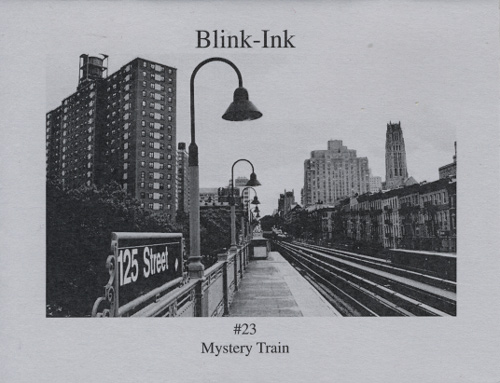Blink Ink – Number 23
Micro-mag Blink Ink has seen some exciting changes thus far in 2016, including a new and improved website, a special glossy-covered issue at the beginning of the year, and in the latest, #23, a postcard insert of Kristin Fouquet’s black and white, gender-bending photograph “Edgar Allen Poe-Boy.” But there’s more to Blink Ink than a new site and a fun postcard: there are also great little poems packed into every issue, issues small enough to comfortably fit in the back pocket of one’s jeans. Micro-mag Blink Ink has seen some exciting changes thus far in 2016, including a new and improved website, a special glossy-covered issue at the beginning of the year, and in the latest, #23, a postcard insert of Kristin Fouquet’s black and white, gender-bending photograph “Edgar Allen Poe-Boy.” But there’s more to Blink Ink than a new site and a fun postcard: there are also great little poems packed into every issue, issues small enough to comfortably fit in the back pocket of one’s jeans.
The theme this issue is “Mystery Train,” and upon opening the front cover, readers are met with a table of contents labeled to fit the theme. Contributors are “seated” in the dining hall, in coach, in Pullman cars, a cute twist on the usual contributor page. Who knew it was possible to be excited about a table of contents?
Of course, the actual poems are just as exciting. The contents range from work by Petronius Arbiter written circa 54 C.E., to contemporary writers like Jennifer Davis and Gay Degani.
Degani demonstrates this contemporariness with a poem titled “Stephen King” in which the speaker summons the horror writer in a type of séance so she may receive an autograph, and with “Prayer for the Children,” an image-rich piece about children waiting for their mother, a sex worker, to return with money for dinner.
Degani isn’t the only writer to examine the darkness that resides in everyday life (or trains). Meg Tuite in “Rhythmic Blur of Landscape” tells about encountering a public masturbator on an overnight train in language so vivid readers will—a little unfortunately in this case—feel like they’re right there with them. Likewise, in “The Hatbox” by Craig Faustus Buck: a mutilated corpse is discovered on a train and Buck’s morbid sense of humor and vibrant descriptions help bring the scene to life.
The theme of trains continues, whether the speaker is on them, like in “Soulless” by Len Kuntz as speaker and daughter travel to meet his new romantic interest, or just thinking about them, like Frankie in Isobel Horsburgh’s “Campfire Song”: “They often sang round the campfire at night: ‘City of New Orleans’, ‘Freight Train’, ‘Blues in the Night’. [ . . . ] // Huddled against a dry-stone wall, Frankie wondered to herself, why were songs about trains so sad?” While we walk through the train cars, we’re met with all types of variety, which carries over from subject to style.
In “Where Trains Have Been,” Jennifer Davis utilizes almost only dialogue for a light take on a serious subject. Kona Morris writes pieces made up of only a sentence or two that beg to be read multiple times while we search the bare bones for more meaning. Each piece is uniquely enjoyable. Perhaps most enjoyable for me was Winston Van Lance’s “Supernatural Historical Adventures,” in which the historical figures are reimagined with a twist. “Clone Winston Churchill, Cyborg Einstein, and Teddy Roosevelt the Were-bear” are vacationing. Teddy and Einstein are dating each other. George Washington the ghost makes an appearance, a little over-excited about trains. It’s a whimsical piece that made me crack a smile at the absurdity while still appreciating the cleverness—of course Teddy Roosevelt should be a were-bear instead of a werewolf.
Blink Ink may be a little mag, but it’s holding a lot between its covers. Board #23 and see what each train car has in store. You won’t be disappointed.
[www.blink-ink.org]





